The following is a manuscript to a lecture I held at the conference »Sortieren, Sammeln, Suchen, Spielen: Die Datenbank als mediale Praxis« in Braunschweig (Germany) on the 4th of March 2011. There’s also a audio recording of the talk, but only in German language. Please forgive me my clearly audible nervousness. It gets much better after a while. The lecture will be published soon in a heavily edited form and combined with a talk by Robin Krause [»Datenbanken als Spielräume«] in the official conference proceedings and can be preordered on Amazon.de, though also in German language. This is my first try to translate a text of mine into English, please feel free to give feedback and suggest corrections.
The database aesthetics of video game spaces
Lecture manuscript
[00] The beginning
[01] The forest of ZORK
„To the north a narrow path winds through the trees“. (Zork 1980)
When we enter the forest north of the white house in the classical text-adventure ZORK, we are standing on a path that runs from the south to the north. We can leave it in the west and the east, though then the game will only tell us that we now find ourselves in a forest: „This is a forest, with trees in all directions“. (Zork 1980) When we try to move on, we come across dense undergrowth and need to turn back. Sooner or later, we are back on the path that leads from the south to the north through the forest. If we finally follow it, we discover a very large tree with low hanging branches – the „particularly large tree“. And this tree – that is the point! – is the only tree of the whole game. Because – as Claus Pias suitably puts it: „Not all words in the texts refer to objects, but it’s only playable which has a reference.“ (Pias 2007, 405, transl. by C.H.)
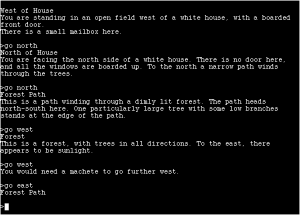
The remaining forest of ZORK belongs – in the words of Claus Pias – to the „world of intermediate texts“ and is pure „literature“ (Pias 2007, 405, transl. by C.H.). It’s reduced to a summarizing object – called „forest“ or „trees“ – and can only be called up rudimentarily. Thus, the forest is a text that isn’t referring to other objects in the database, or is only referring to them to a very limited extent, and therefore would also be in good keeping in a book. It may be a part of the database, but it isn’t a part of the game mechanics. The parser command „examine“ just triggers a simple: „There‘s nothing special about the forest.“ (Zork 1980) In contrast to its purely literary colleagues, we can not only examine the „particularly large tree“ by the wayside, but climb it as well. In its crown, which is another object in the database, we find a relevant game item – a crystal-studded egg. In short: The „particularly large tree“ can individually be called up by the player through different parser commands like „examine“, „kick“ and „climb“. And it refers to other specific objects, making it an active element of the database, the game mechanics and the space of ZORK.
[02] The space of ZORK
When we free the forest of ZORK from all redundancies, the game-mechanically inactive elements of the database, all that remains are the path, the very large tree and a forest clearing. On a map of the world of ZORK the whole turns out to be – as Claus Pias correctly points out (see Pias 2007, 410) – a mathematical graph. It’s a network of texts that are connected through direct links, or – to use the more effective metaphor of the game – through paths. And the database can only be retrieved along this linear pathways. What lies beyond remains redundant, inactive, dead. Like numbers in a phone book that aren’t referring to a valid connection.
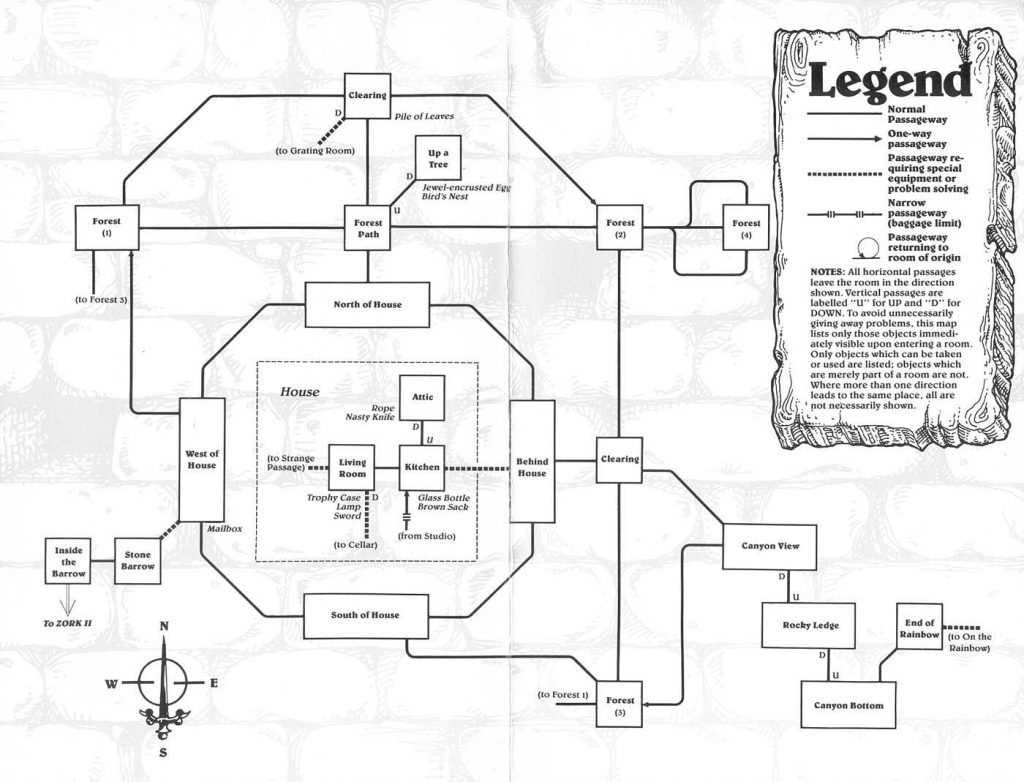
Hardly surprising then that ZORK – „The Great Underground Empire“ – to a large extent takes place under the earth, in the narrow tunnels of a dungeon. The cave as a space, along with its specific features – tight, dark, labyrinthine –, is well anchored in the cultural memory of the players. From the very beginning, the choice of spatial metaphor eliminates all redundancy, since no player can be outside of the corridors digged through solid rock, and thus no database needs to be: „There is a wall there.“ (Zork 1980) The space of the forest, however, can convince neither as an element of the database nor as an interface to the database of ZORK. Too few algorithms impart depth to the purely textual descriptions of the game. The linear spatial logic of ZORK goes too much against the grain of the inherent contingency of a forest. Weak metaphors are used – e.g. the dense undergrowth – to artificially limit both the moving radius of the player and the size of the database. And the absolute homogeneity of the forest instances will only allow to lose orientation for a short duration. Thus, ZORK irritates the cultural memory of the player and of all those entries therein that deal with the spatial properties of the forest – big, cluttered, impassable. Only the literary suggestion of a forest is left, which stays without consequences for the spatial logic and is irrelevant for the game mechanics. Considering what the fantasy genre, fairy tales and myths would yet have to tell about the forest, ZORK isn’t tapping the players’ cultural memory in a very creative way. There’re no bread crumbs to lead us the way. There’re no will-o’-the-wisps to lure us deeper into the forest. And there’s no Big Bad Wolf to stalk us. Not until we are in the darkness of a dungeon, the evil „grue“ is waiting to eat us, if we forgot the lantern. The forest of ZORK, however, is more straightforward and more boring than any monocultural forestry in Lower Saxony. We remember: „There‘s nothing special about the forest.“ (Zork 1980) A sober piece of prose remains, the redundant description of a space called „forest“ in the database. What the existence of the forest in the database is promising comes into conflict with the reality of the game, and the interface metaphor of the path – that leads straight through the forest – is needed to correct this irritation. This is the database aesthetics of the (text-)adventure: Data as edge vegetation to a informatical dirt track called video game.
[03] Interim findings I
We can summarize the first observations:
- The database of the text adventure ZORK needs to be differentiated: In one part that is active and connected inseparably with the game mechanics, and another part that is only made observable by the game, but is ludically redundant.
- The boundary between the active and the inactive part of the database is defined by the spatial logic of the text adventure. In the case of ZORK, it’s only an active part of the database which is present as a node along the edges of a graph. Everything else is pure literature, inactive and not part of the mechanics of the game.
- Not only is space an interface to the database, but the database also serves as an interface to space. Thus, ZORK uses the description of a path in the form of a text in its database – as a metaphor for the edges of the graph.
- But both space and database can fail as an interface of a text adventure. In ZORK the graph can neither design the forest consistently, nor can the forest obscure the linear logic of the graph. Only the interface metaphor of the path resolves the irritation of the player.
- And this irritation is created – so I want to argue – because we tie personal experiences and cultural memories to the content of the database, which can just not be redeemed by the game mechanics.
[04] The forest of FABLE
Nearly 30 years later the forest of the database has become more diverse and dense. No longer just texts but movies, graphics, sounds, music, animations and polygons vegetate on ever-increasing storage media. The forest no more needs to be described literarily, but can be represented using multimedia. The action role-playing game FABLE (2004) can make use of the full potential of „navigable space“ (Manovich 2001, 269) – as Lev Manovich calls the Euclidean coordinate space of modern computer games: an autonomous cultural form, a cultural interface to databases imbued by culture (see Manovich 2001, 215). And indeed, the forest of FABLE presents itself to us in all its audiovisual, three-dimensional glory. No longer just a short „this is a forest“ (Zork 1980), but dozens of vividly modeled and textured trees are spread before us. Furthermore sporadic ground cover, damp mist among the tall pines and an atmospheric soundscape that wants to make clear: this space is a forest.
But upon closer inspection additional details can be perceived: An empty and wide green space that runs through the forest. Picket fences, ruinous walls and large boulders to both sides of the elongated clearing. A glance at the schematic map at the top right of the screen finally confirms what the polygonal geometry already indicates. By no means are we moving through an open forest area, but through a system of tubes, which is merely surrounded by forest. The question, wether we can leave the tubes or not, could polemically be answered by ZORK: „There is a wall there.“ (Zork 1980)
[05] The space of FABLE
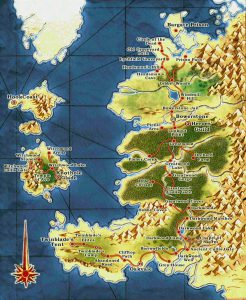
The parallels to ZORK can hardly be missed. If we take a closer look to the world map of Albion, a system of linear paths – similar to a text adventure – becomes evident. The great forests of the world map are only an illusion. The forest of FABLE and its trees are redundant data ornaments of a navigable tunnel space. So little has changed since ZORK. We are still moving from node to node on the – now a bit wider – edges of a graph. This time, the database is more extensive, but in FABLE we can still only activate it along linear paths. Where the adventure genre could always get away with the imperative „That doesn’t work that way!“, the modern 3D action adventure game gets into trouble. Everything that isn’t referred to by the game mechanics in any way, has to be put behind walls, fences and rocks to protect it from the attempted manipulations of the player.
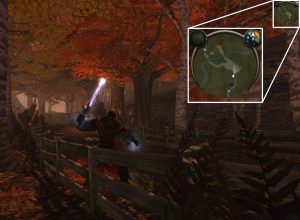
Thus, the „navigable space“ (Manovich 2001, 269) of FABLE constitutes no interface to a large part of the data, but rather we encounter it as a separating layer between the game and the database. Such as a hybrid of a gallery and a ghost train ride, FABLE only allows us proximity and access to data that is deliberately placed along the rail. Since our muscle-bound hero isn’t able to jump over a basic wooden fence, this time we can only look at the forest through invisible walls.
[06] The fairy tale of FABLE (The fairy tale of space)
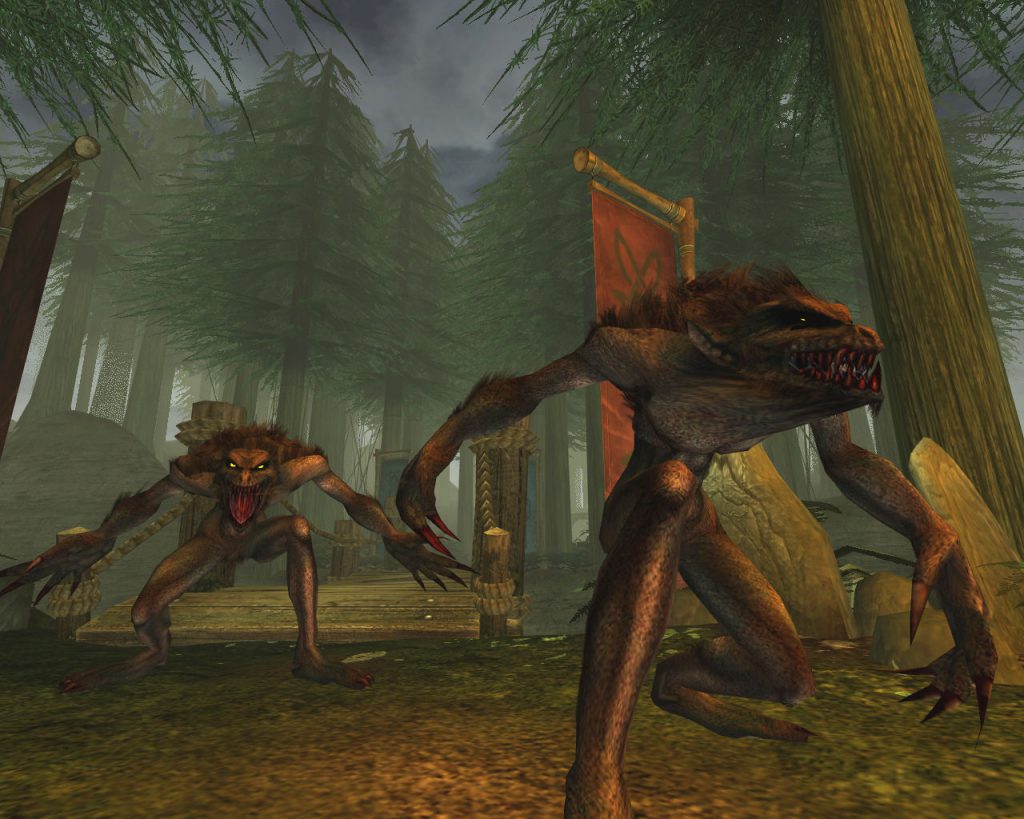
However, where ZORK could persuade us that nothing in its forest is special anyway, the forest of FABLE evokes desires. Because this time the forest is actually of interest to the player. FABLE is – in the words of Mathias Mertens – a „memory space game“ which we „play to be able to watch“. It’s filled to the brim with stereotypes and allusions to fables [sic!] and folk tales, a „database of cultural socialization.“ (Mertens 2007, 53, transl. by C.H.) Just as we can cruise through the urban culture of Liberty City with a nice car in GTA IV (2008), the database of FABLE invites us to wander in the footsteps of heroes, Hansel, Gretel and Little Red Riding Hood. And we’d like to give in to this temptation, leave the secure path to Grandmother’s house, get lost in the dark forest, and finally meet the Big Bad Wolf. But: FABLE and its surreal tube space won’t let us. The game raises expectations and needs with its database that its space can’t or won’t fulfill. We meet the Big Bad Wolf finally by the dozen, however, not in the dense forest, but right in the middle of the path.
FABLE doesn’t take its database seriously. The game uses the rich pool of stereotypical mythology alone in order to cover up its game mechanics with a comfortable since very familiar clothing. The wolf is bad, therefore he is an enemy and must be destroyed. The cliché provides unambiguous orientation for the player. The long pathway through the forest only serves the purpose of stalling for time and of distancing the functional nodes of the game from each other sufficiently. Once traversed, it’s become redundant and can now be skipped through teleportation. Rarely a path of FABLE has therefore to be wandered more than once, and thus no part of the database has to be called up more than once. Here, FABLE doesn’t open up to us the space of a fairy tale, but tells us a fairy tale of space.
[07] Interim findings II
Let’s summarize again:
- Since ZORK, the database has become more extensive and the path between the active elements of the database a little wider. The fundamental space logic of ZORK – the graph – and the limited handling of the database, however, remained unchanged.
- But FABLE adds a new phenomenon: The extent and level of detail of the database elements evokes the attention of the player, which could still be prevented by simple omission in the text-adventure. But, the forest of FABLE encourages exploration through its clearly visible presence. Considering its spatial limitations and the lack of game-mechanical relevance behind the forest, the game has to keep the players away from its database through visual metaphors.
- I argue: Databases in video games want to be explored! Invisible walls are seen as bad game design both in classical games journalism and the gaming community. What the database makes visible must be tangible or has to be consistently protected against the player behind the thick walls of a dungeon, a space station or a underwater city.
[08] The space of THE PATH
Let’s return – this time quite literally – to the path. In THE PATH (2009) a wide pathway leads through the forest, too. Our task is clear: “Go to Grandmother’s house and stay on the path” (The Path 2009). If we follow this instructions, we arrive at Grandmother’s house within minutes and the game is lost. „You failed!“. (The Path 2009)
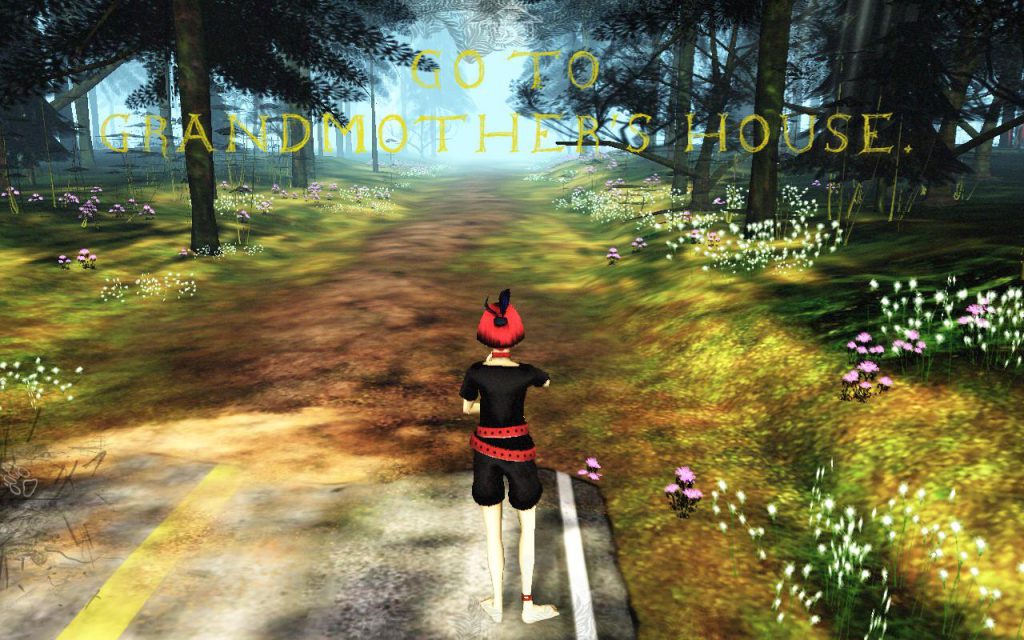
THE PATH very skillfully makes fun of games like FABLE, their narrow tunnel spaces and their rigorously detached databases. Where in FABLE the game ends, if we submit to the temptation of the forest, we fail in THE PATH, if we follow the edge of the graph – the path – to the final node – Grandmother’s house. The game resists a spatial logic which consists solely of nodes and edges, or rather a network of navigable tubes. If we want to have fun and success in THE PATH, we should violate the only rule of the game and leave the pathway. Like Little Red Riding Hood, we have to ignore what was inflicted to us by other games again and again: that the game ends at the margins of the path and we may not have access to the rest of the database. Instead of just traversing through the fairy tale of space, now we are actually moving through the fairy tale as a space and as a database.
[09] The fairy tale of THE PATH (The fairy tale as space)
And THE PATH takes its database seriously: There’s nothing in the database that we couldn’t take a close look at. The database aesthetics of the adventure is reversed: The pathway is now a game-mechanically redundant void and its former edge vegetation is a gorgeous forest of data. The goal of THE PATH isn’t to find the fastest way to the end of the game, but to wander at leisure through the database, and to discover its – as Henry Jenkins calls it – „spatial story“ (Jenkins 2006, 678). Even more so, however, we are dealing with a „memory palace“ (Jenkins 2006, 685), a freely navigable database space containing the cultural memory of fairy tales – in particular Little Red Riding Hood. And suddenly, the forest makes complete sense as an element of the database and as an interface metaphor for the space of the game. It’s the forest as we know it from fairy tales: Mysterious, dark, cluttered and large. In THE PATH it’s actually infinite. The ends of the forest are short circuited, the room resembles less a finite area, but more a donut. Thus, it doesn’t take long until we get lost in the database and can’t find our way back to the path.
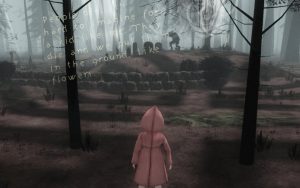
This way, the forest of THE PATH doesn’t only look like a fairy tale forest, but it also functions accordingly. We do not encounter interesting locations because a path directs us to them, but by coincidence. And sooner or later we also run into the Big Bad Wolf. However, this time not as one of many enemies on a linear battlefield, but as an archetypal figure that tries to seduce us and has just been waiting for us to leave the secure path. This is the database aesthetics of THE PATH: An open, seductive data forest, which is traversed by the redundant edge of a graph.
[10] Conclusion
We can summarize in conclusion:
- The database aesthetics of the adventure genre is common even among modern video games. However, it is not the only possible aesthetic. Open-world games and in particular ludic experiments like THE PATH offer the potential to use the database not only as marginal ornamentation, but as a major element of the game.
- In addition, the cultural memory, which is tied to the objects in the database, can be utilized productively for the game mechanics and the spatial logic. A highly structured spatial logic such as the graph can plausibly be represented through the database as a dungeon, as well as an open, contingent geometry through a forest.
- It’s worthwhile to look at the databases of video games not only as audiovisual surfaces. In the practical execution of the game, they often reveal themselves as complex cultural interface metaphors for specific game mechanics and spatial logics. Similarly, computer games are aestheticizing their databases. And something has now hopefully become clear: There is something special about the forest!
[11] Outlook („Raumtemperatur“/„Topografie von Spielräumen“)
Some additional information: In the future, the research project „Topografie von Spielräumen – Untersuchungen zur kulturellen Verortung von Computerspielen“ [discontinued], on which I work along with Robin Krause – whose talk you have heard yesterday („Datenbanken als Spielräume“) – and Mathias Mertens, wants to further explore the relationships between culture, database and space in different „game spaces“. Those interested can find further remarks on the aesthetics of the database and spaces of selected video games in my first publication „Raumtemperatur – Marshall McLuhans Kategorien »heiß« und »kalt« im Computerspiel.“ (Huberts 2010)
I thank you for your attention and look forward to your questions!
Bibliography
- Huberts, Christian (2010) Raumtemperatur. Marshall McLuhans Kategorien »heiß« und »kalt« im Computerspiel. Göttingen: Blumenkamp.
- Jenkins, Henry (2006) Game Design as Narrative Architecture. In: Salen, Katie/Zimmerman, Eric (Hrsg.) The Game Design Reader: A Rules of Play Anthology. Cambridge: MIT Press. S. 670-689.
- Manovich, Lev (2001) The Language of New Media. Cambridge, MA; London: The MIT Press.
- Mertens, Mathias (2007) »A Mind Forever Voyaging«. Durch Computerspielräume von den Siebzigern bis heute. In: Holtorf, Christian; Pias, Claus (Hrsg.) Escape! Computerspiele als Kulturtechnik. Köln; Weimar; Wien: Böhlau Verlag; S. 45–54.
- Pias, Claus (2007) Adventures Erzählen Graphen. In: Bruns, Karin; Reichert, Ramón (Hrsg.) Reader Neue Medien. Texte zur digitalen Kultur und Kommunikation. Bielefeld: transcript Verlag; S. 398–419.
Ludography
- Anderson, Tim et al. (1980) Zork 1. The Great Underground Empire. Infocom. System: Commodore 64.
- Harvey, Auriea; Samyn, Michaël (2009) The Path. Tale of Tales. System: PC.
- Lashley, Simon; McLeman, Keith (2008) Grand Theft Auto IV (GTA IV). Rockstar North; Rockstar Games. System: Sony Playstation 3, Microsoft Xbox360, PC.
- Molyneux, Peter (2004) Fable. The Lost Chapters. Lionhead Studios; Microsoft Studios. System: PC, Mac OS X.